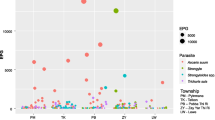Abstract
A survey was performed to determine if infection with gastrointestinal parasites differs between the rural and urban poor inhabitants of Guatemala. A total of 317 stool samples from children in two towns, one rural and one urban, were examined using the formalin–ether concentration method. The overall prevalence of parasites in infected children was 67%, 20%, 30%, and 22%, respectively for Ascaris lumbricoides, Trichuris trichiura, Giardia duodenalis and Entamoeba histolytica in the rural town of La Mano de Leon and 49%, 14%, 15%, and 21%, respectively in the urban town of Santa Maria de Jesus. Two sub-studies were carried out to determine the effects of (1) gender and (2) age on the rate of parasitic infections. Female children in the 1-to 6-year-olds age group in Santa Maria de Jesus had more infections with A. lumbricoides and T. trichiura when compared to La Mano de Leon. A. lumbricoides was most prevalent in Santa Maria de Jesus. These results propose that accessibility to tourism and trade decreases the risk for the establishment of parasitic diseases in children of Guatemala possibly due to improvements in basic nutrition and availability of health care.
Similar content being viewed by others
References
Gupta, M. C., & Urrutia, J. J. (1982). Effect of periodic antiascaris and antigiardia treatment on nutritional status of preschool children. The American Journal of Clinical Nutrition, 36, 79–86.
Farthing, M. J. G., Mata, L., Urrutia, J. J., & Kronmal, R. A. (1986). Natural history of Giardia infection of infants and children in rural Guatemala and its impact on physical growth. The American Journal of Clinical Nutrition, 43, 395–405.
Rosner, B. (2000). Fundamentals of Biostatistics (5th ed., p. 792). Pacific Grove, California: Duxbury.
Omar, M. S., Mahfouz, A. A. R., & Moneim, M. A. (1995). The relationship of water sources and other determinants to prevalence of intestinal protozoal infections in a rural community of Saudi Arabia. Journal of Community Health, 20, 433–440.
de Silva, N. R., Priyanka Jayapani, V. P., & de Silva, H. J. (1996). Socioeconomic and behavioral factors affecting the prevalence of geohelminths in preschool children. South East Asian Journal of Tropical Medicine and Public Health, 27, 36–42.
Flores, V. M., Raymundo, L. A. M., Iwashita, A. T., Cuba, F. S., & Herencia, E. G. (2002). Distribution of entero-parasitic infections in the Peruvian Highland: study carried out in six rural communities of the department of Puno, Peru. Revista de gastroenterología del Perú, 22, 304–309.
Moraes, L. R. S., Cancio, J. A., & Cairncross, S. (2004). Impact of drainage and sewerage on intestinal nematode infections in poor urban areas in Salvador, Brazil. Transactions of the Royal Society of Tropical Medicine and Hygiene, 98, 197–204.
Saksirisampant, W., Prownebon, J., Kanmarnee, P., Thaisom, S., Yenthakam, S., & Nuchprayoon, S. (2004). Prevalence of parasitism among students of the Karen Hill-Tribe in Mae Chame District, Chiang Mai Province, Thailand. Journal of the Medical Association of Thailand, Chotmaihet Thangphaet, 87, S278–S283.
Rinne, S., Rodas, E. J., Galer-Unti, R., Glickman, N., & Glickman, L. T. (2005). Prevalence and risk factors for protozoan and nematode infections among children in an Ecuadorian highland community. Transactions of the Royal Society of Tropical Medicine and Hygiene, 99, 585–592.
Siddiqui, M. I., Bilqees, F. M., Iliyas, M., & Perveen, S. (2002). Prevalence of parasitic infections in a rural area of Karachi, Pakistan. The Journal of Pakistan Medical Association, 52, 315–320.
Melvin, D. M., & Mata, L. J. (1971). Intestinal parasites in a Mayan-Indian village of Guatemala. Revista Latino Americana de Microbiologia, 13, 15–19.
Grazioso, C. F., Isalgue, M., de Ramirez, I., Ruz, M., & Solomons, N. W. (1993). The effect of zinc supplementation on parasitic reinfestation of Guatemalan schoolchildren. The American Journal of Clinical Nutrition, 57, 673–678.
Anderson, T. J., Zizza, C. A., Leche, G. M., Scott, M. E., & Solomons, N. W. (1993). The distribution of intestinal helminth infections in a rural village in Guatemala. Memorias do Instituto Oswaldo Cruz, 88, 53–65.
Fernandez, M. C., Verghese, S., Bhuvaneswari, R., Elizabeth, S. J., Mathew, T., Anitha, A., et al. (2002). A comparative study of the intestinal parasites prevalent among children living in rural and urban settings in and around Chennai. Journal of Communicable Diseases, 34, 35–39.
Sayyari, A. A., Imanzadeh, F., Yazdi, S. A. B., Karami, H., & Yaghoobi, M. (2005). Prevalence of intestinal parasitic infections in the Islamic Republic of Iran. Eastern Mediterranean Health Journal, 3, 377–383.
Roche, J., & Benito, A. (1999). Prevalence of intestinal parasite infections with special reference to Entamoeba histolytica on the Island of Bioko (Equatorial Guinea). American Journal of Tropical Medicine and Hygiene, 60, 257–262.
Kroeger, A., Schulz, S., Witte, S. B., Skewes-Ramm, R., & Etzler, A. (1992). Helminthiasis and cultural change in the Peruvian rainforest. Journal of Tropical Medicine and Hygiene, 95, 104–113.
Bundy, D. A. P., & Cooper, E. S. (1988). The evidence for predisposition to trichuriasis in humans: Comparison of institutional and community studies. Annals of Tropical Medicine and Parasitology, 82, 251–256.
Wongjindanon, N., Suksrichavalit, T., Subsutti, W., Sarachart, T., Worapisuttiwong, U., & Norramatha, P. (2005). Current infection rate of Giardia lamblia in two provinces of Thailand. South East Asian Journal of Tropical Medicine and Hygiene, 36, 21–25.
Author information
Authors and Affiliations
Corresponding author
Rights and permissions
About this article
Cite this article
Jensen, L.A., Marlin, J.W., Dyck, D.D. et al. Effect of Tourism and Trade on Intestinal Parasitic Infections in Guatemala. J Community Health 34, 98–101 (2009). https://doi.org/10.1007/s10900-008-9130-8
Published:
Issue Date:
DOI: https://doi.org/10.1007/s10900-008-9130-8




